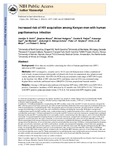| dc.description.abstract | Background
Few data are available concerning the effect of human papillomavirus (HPV) infection on HIV acquisition.
Methods
HIV-seronegative, sexually active 18-24 year-old Kenyan men within a randomized trial of male circumcision provided penile exfoliated cells from two anatomical sites (glans/coronal sulcus, and shaft) at baseline. The GP5+/6+ PCR assay ascertained a wide range of HPV DNA types at the baseline visit. Risk of HIV infection [95% confidence interval (CI)] was estimated using Kaplan-Meier methods, and hazard ratios (HR)[95% CI] from proportional hazards models.
Results
Among 2,168 uncircumcised men with baseline HPV data, 1,089 (50%) were HPV DNA positive. Cumulative incidence of HIV infection by 42-months was 5.8% [95% CI 3.6, 7.9] in men with HPV-positive glans specimens versus 3.7% [1.8, 5.6] in men with HPV-negative glans specimens (p=0.01). Controlling for subsequent circumcision status, baseline HSV-2 serostatus, and sexual and sociodemographic risk factors, the HR of HIV infection in men with HPV-positive glans specimens was 1.8 [1.1, 2.9] compared to men with HPV-negative glans specimens.
Conclusion
Results suggest an independent, increased risk of HIV seroconversion among HPV positive men. If confirmed in other studies, HPV prevention could be another tool for HIV prevention. | en |


